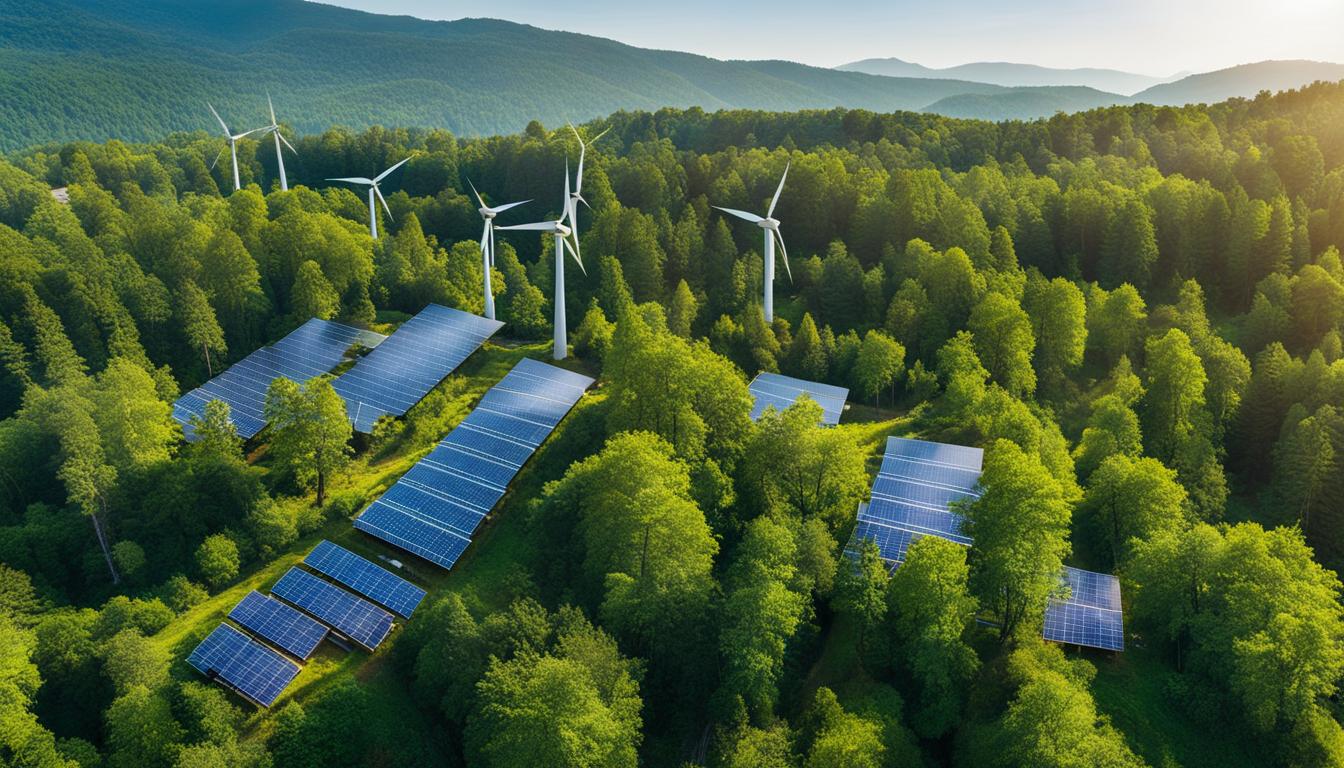Green IT Initiatives: Beyond the Basics
Advanced Green IT Initiatives, sustainable technology practices, and eco-friendly IT solutions are at the forefront of creating an environmentally sustainable future. In this article, we will explore the importance of Green IT, the benefits it offers, the challenges in its implementation, and strategies to reduce the environmental impact of existing technologies.
Key Takeaways:
- Green IT aims to minimize the negative effects of IT operations on the environment.
- Implementing Green IT practices leads to cost savings and improved corporate reputation.
- Challenges in Green IT implementation include initial costs and conflicting initiatives.
- Reducing the environmental impact of IT assets involves optimizing network infrastructure, using energy-efficient computing practices, and promoting renewable energy sources.
- Green technology encompasses a wide range of innovations, contributing to a more sustainable future.
The Benefits of Green IT
Green IT offers numerous benefits to organizations and the environment. One of the key advantages is its ability to promote energy-efficient computing practices, which in turn reduces carbon emissions and contributes to carbon footprint reduction strategies. By adopting energy-efficient CPUs, servers, and peripherals, as well as implementing power management techniques, organizations can minimize their energy consumption and improve resource efficiency. This not only helps in limiting global warming but also leads to cost savings through reduced energy bills.
Moreover, green IT initiatives contribute to compliance with environmental regulations and improved environmental, social, and governance (ESG) performance. By implementing sustainable technology practices, organizations demonstrate their commitment to responsible environmental stewardship. This can enhance their reputation among customers, investors, and other stakeholders, leading to a competitive advantage in the market.
Furthermore, green IT implementation raises awareness and improves corporate culture. It encourages employees to adopt eco-friendly IT solutions and adopt sustainable behaviors in their daily work. This cultural shift towards sustainability can have far-reaching effects beyond IT operations, permeating throughout the entire organization.
Challenges of Green IT Implementation
Implementing green IT practices comes with its own set of challenges. From the initial cost of adopting green technologies to cultural resistance and conflicting initiatives, organizations must navigate various obstacles. Let’s explore some of the key challenges and how they can be addressed.
1. Initial Cost:
Transitioning to green IT often requires investing in new technologies and upgrading legacy systems. This initial cost can be a barrier for businesses, especially smaller ones with limited budgets. However, it’s important to consider the long-term cost savings and environmental benefits that green IT can bring. Developing a detailed cost analysis and creating a phased implementation plan can help organizations overcome this challenge.
2. Cultural Resistance:
Introducing new ways of working and implementing green computing best practices may face resistance from employees who are accustomed to traditional IT systems. To address this challenge, organizations should focus on employee engagement and education. Providing training on the benefits of green IT and creating an organizational culture that embraces sustainability can help overcome resistance and drive adoption.
3. Conflicting Initiatives:
In some cases, initiatives aimed at reducing carbon emissions may have unintended negative environmental impacts. Organizations need to carefully evaluate and prioritize which systems to address first for maximum impact. Conducting thorough assessments and working with sustainability experts can help identify potential conflicts and find the best solutions that align with the organization’s overall green IT objectives.
4. Redesigning Data Centers:
Data centers are a significant source of energy consumption in the IT industry. Redesigning data centers to be more energy-efficient requires careful planning and investment. Embracing environmentally friendly data center designs, such as using efficient cooling systems and maximizing server utilization through virtualization, can help reduce energy consumption and minimize environmental impact.
By acknowledging and addressing these challenges, organizations can successfully implement green IT practices and contribute to a more sustainable future. Overcoming initial cost barriers, fostering a culture of sustainability, managing conflicting initiatives, and optimizing data center designs are crucial steps in the journey towards environmentally friendly IT operations.
Environmental Impact of Existing Technologies
When it comes to sustainable IT infrastructure, it is crucial to understand the environmental impact of existing technologies. Different types of IT hardware have varying effects on the environment throughout their lifecycle. By examining these impacts, we can identify areas for improvement and work towards a greener future in the realm of IT.
Data center systems are known to consume a significant amount of energy, contributing to greenhouse gas emissions. It is essential to make data centers more energy-efficient by implementing technologies such as virtualization and optimizing cooling systems. Networking equipment, such as routers and servers, also consume energy during information transmission. By investing in energy-efficient networking solutions, we can reduce unnecessary energy consumption in this area.
Data storage devices, including hard drives and solid-state drives, contribute to energy consumption during data transfer and storage processes. Efforts should be made to minimize inefficiencies and optimize data storage to reduce energy usage. Additionally, end-user devices, such as desktop computers and smartphones, contribute to carbon emissions and electronic waste. Implementing responsible recycling initiatives and promoting longevity in these devices can help mitigate their environmental impact.
| IT Hardware | Environmental Impact |
|---|---|
| Data center systems | Significant energy consumption and greenhouse gas emissions |
| Networking equipment | Energy consumption during information transmission |
| Data storage devices | Energy consumption during data transfer and storage processes |
| End-user devices | Contribute to carbon emissions and electronic waste |
Computer chips, particularly graphics processing units (GPUs), are notorious for consuming excessive amounts of energy. This not only drives up electricity usage but also contributes to heat generation and requires cooling solutions that further consume energy. Efforts to develop energy-efficient CPUs and GPUs can help reduce power consumption in IT systems. Similarly, software plays a significant role in environmental impact. Certain applications consume large amounts of data, leading to increased energy usage. By optimizing software and utilizing energy-efficient algorithms, we can minimize the environmental footprint of IT systems.
In conclusion, understanding the environmental impact of existing technologies is crucial for building a sustainable future. By addressing the energy consumption and carbon emissions associated with data centers, networking equipment, data storage devices, end-user devices, computer chips, and software, we can make significant progress towards achieving a more eco-friendly IT industry. Through continuous innovation and conscious decision-making, we can create a greener and more sustainable future for IT infrastructure.
How to Reduce Environmental Impact
Reducing the environmental impact of IT assets is crucial in promoting sustainable practices. By implementing green networking and energy-efficient computing, businesses can significantly minimize their carbon footprint and contribute to a greener future.
Green Networking
Green networking involves optimizing network infrastructure to reduce energy consumption. This can be achieved by implementing energy-efficient network devices, such as switches and routers, and adopting power management techniques. By maximizing the efficiency of data transmission and reducing unnecessary energy consumption, organizations can reduce their environmental impact while maintaining an efficient and reliable network.
Energy-Efficient Computing
Energy-efficient computing practices play a vital role in reducing the environmental impact of IT operations. Businesses can start by using energy-efficient CPUs, servers, and peripherals. These devices are designed to consume less power while maintaining optimal performance. Implementing power management techniques, such as sleep mode and automatic shutdown, also contributes to energy savings. By optimizing resource utilization and minimizing energy consumption, organizations can lower their carbon emissions and reduce their overall environmental footprint.
Proper disposal and recycling of electronic waste is another essential aspect of reducing environmental impact. Organizations should adhere to responsible e-waste management practices, ensuring that outdated or non-functional IT equipment is recycled or disposed of properly. Recycling initiatives help recover valuable resources from old devices while preventing harmful substances from polluting the environment.
In summary, embracing green networking and energy-efficient computing practices is key to reducing the environmental impact of IT assets. By optimizing network infrastructure, utilizing energy-efficient devices, and responsibly managing electronic waste, businesses can contribute to a sustainable future while reaping the benefits of cost savings and improved resource efficiency.
| Benefits of Green Networking and Energy-Efficient Computing | Challenges of Implementation |
|---|---|
|
|
The History and Scope of Green Technology
Green technology has a long history of sustainable innovation. Practices such as geothermal heating, wind energy, and solar power have been used for centuries. These eco-friendly solutions harness natural resources to generate power and reduce reliance on fossil fuels. They have gained prominence in recent years due to increasing concerns about climate change and the need for clean energy sources.
In addition to renewable energy, green technology encompasses a wide range of innovations across various sectors. One prominent area is the development of eco-friendly vehicles. Electric cars, hybrid vehicles, and hydrogen fuel cell vehicles are examples of clean transportation options that aim to reduce carbon emissions and air pollution.
Green technology is not limited to energy and transportation. It extends to various aspects of our daily lives and industries, including waste management and recycling, smart homes, sustainable agriculture, and green building materials.
Furthermore, green technology plays an important role in promoting sustainable innovation. It encourages the development and adoption of technologies that minimize environmental impact and promote a more sustainable future. By embracing green technology, businesses and individuals can contribute to the global effort to combat climate change and create a more eco-friendly world.

Conclusion
Green IT initiatives go beyond the basics of environmental sustainability. They offer numerous benefits to organisations, including cost savings, compliance with regulations, and improved ESG performance. Implementing green IT practices helps reduce carbon emissions, limit global warming, and contribute to a sustainable future.
However, there are challenges in implementing green IT, such as high initial costs and conflicting initiatives. By adopting energy-efficient computing practices, promoting renewable energy sources, optimising IT infrastructure, and embracing green technologies, businesses can reduce their environmental impact and work towards a more sustainable future.
Green IT is an essential component of the broader strategy towards achieving a greener and more eco-friendly world. By embracing the adoption of green technology, we can ensure a sustainable future for generations to come.
FAQ
What is Green IT?
Green IT, also known as green information technology, is the practice of creating and using environmentally sustainable computing resources. It aims to minimize the negative effects of IT operations on the environment by designing and managing servers, PCs, and other computer-related products in an environmentally friendly manner.
When did the concept of Green IT emerge?
The concept of Green IT emerged in 1992 with the launch of the Energy Star program by the U.S. Environmental Protection Agency (EPA).
What are the benefits of Green IT?
Green IT offers various benefits, including reducing carbon emissions, helping organizations comply with regulations, improving ESG performance, and achieving cost savings through reduced energy consumption and improved resource efficiency.
What are the challenges of implementing Green IT?
The challenges of implementing Green IT include high initial costs, cultural pushback, prioritizing systems for maximum impact, and potential conflicts with technologies aimed at reducing emissions but with negative environmental impacts.
How do different IT hardware types impact the environment?
Different IT hardware types have varying environmental impacts. Data center systems consume a significant amount of energy, networking equipment consumes energy during information transmission, storage devices consume energy during data transfer and storage processes, end-user devices contribute to carbon emissions, computer chips consume excessive energy, and certain software applications consume large amounts of data.
What can be done to reduce the environmental impact of IT assets?
To reduce the environmental impact of IT assets, green networking can optimize energy consumption, energy-efficient computing practices can be adopted, proper disposal and recycling of electronic waste should be ensured, virtualization and cloud computing technologies can optimize resource utilization, green data storage strategies can be implemented, and renewable energy sources can be integrated into IT infrastructure.
What is the scope of Green Technology?
Green technology encompasses a wide range of innovations, including wastewater treatment, waste management and recycling, electric transport, programmable thermostats, self-sufficient buildings, low carbon construction, carbon capture and storage, LED lighting, vertical farming, composting, wave energy, batteries, green materials, carbon tracking software, and more.
How can businesses benefit from Green IT initiatives?
Green IT initiatives offer benefits such as cost savings, compliance with regulations, improved ESG performance, reduced carbon emissions, and contribution to a sustainable future.
Source Links
- https://www.techtarget.com/searchcio/definition/green-IT-green-information-technology
- https://greenly.earth/en-us/blog/ecology-news/everything-you-need-to-know-about-green-technology-in-2022
- https://www.lancaster.ac.uk/data-science-of-the-natural-environment/blogs/green-computing-a-contribution-to-save-the-environment















